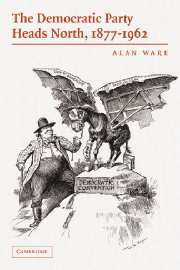Book contents
- Frontmatter
- Contents
- List of Tables
- Preface
- 1 The South and the Democratic Coalition
- 2 The Dynamics of Party Coalition Building
- 3 The Unstable Party Equilibrium, 1877–1896
- 4 The Re-assembling of the Democratic Coalition, 1896–1912
- 5 Woodrow Wilson and the Failure to Re-shape the Democratic Coalition, 1912–1920
- 6 How Could a Winning Democratic Coalition Be Constructed, 1920–1932?
- 7 Democratic Party Dominance or Restored Party Equilibrium, 1938–1952?
- 8 The Two Parties' Coalitions Come Under Threat, 1952–1962
- 9 Conclusions
- Appendix: Note on Data Sources
- Bibliography
- Index
8 - The Two Parties' Coalitions Come Under Threat, 1952–1962
Published online by Cambridge University Press: 15 December 2009
- Frontmatter
- Contents
- List of Tables
- Preface
- 1 The South and the Democratic Coalition
- 2 The Dynamics of Party Coalition Building
- 3 The Unstable Party Equilibrium, 1877–1896
- 4 The Re-assembling of the Democratic Coalition, 1896–1912
- 5 Woodrow Wilson and the Failure to Re-shape the Democratic Coalition, 1912–1920
- 6 How Could a Winning Democratic Coalition Be Constructed, 1920–1932?
- 7 Democratic Party Dominance or Restored Party Equilibrium, 1938–1952?
- 8 The Two Parties' Coalitions Come Under Threat, 1952–1962
- 9 Conclusions
- Appendix: Note on Data Sources
- Bibliography
- Index
Summary
One of the paradoxes of the 1950s is that although it was a decade often regarded as having been dull (politically, as well as in other ways), it was one in which the first stages of major change in the party system became evident. The coalitions of both the major parties came under strain at the same time, yet the main impact of those pressures would not be felt fully until the 1960s. Consequently, despite clear evidence of continuity from the balanced post–New Deal party system that had been re-established during the 1940s, the basis of that balance became undermined. We begin this chapter by considering how the parties performed at various levels of election.
The most obvious point about presidential elections after 1952 is that the closely fought 1960 election might seem to indicate that the balance between the parties established in the 1940s had persisted throughout the decade; the Democrats won that election with a popular plurality of just 0.2 per cent of the vote. However, whilst there may have appeared to be a continuing balance, the basis of it was not quite the same as in the 1940s. In particular, the pivotal position of the coastal states in the Republican Party coalition had been much weakened in the elections of 1952–60. As can be seen in Tables 8.1 and 8.2, the coastal states now possessed only 46 per cent of the Electoral College votes in the Marginal and Democratic Marginal categories combined, whereas for the elections of 1936–48, they had accounted for 72 per cent of the total EC votes in these categories (see Tables 7.4 and 7.5).
- Type
- Chapter
- Information
- The Democratic Party Heads North, 1877–1962 , pp. 209 - 237Publisher: Cambridge University PressPrint publication year: 2006



